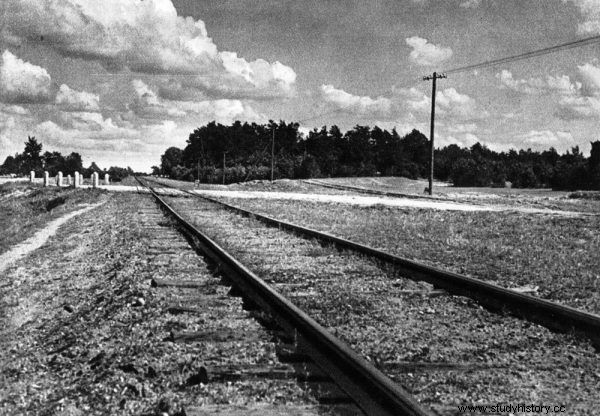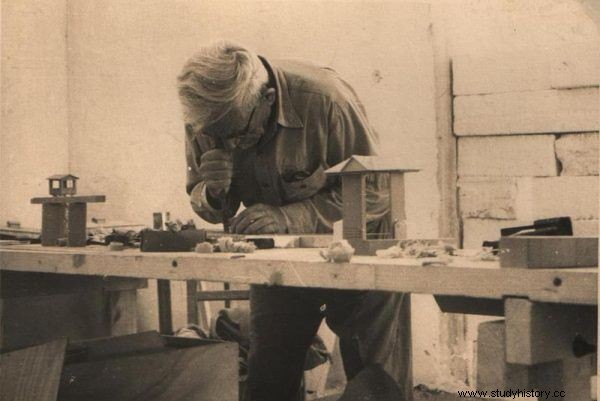This time it wasn't just about running away. "We decided to destroy the camp," says one of the survivors. Prisoners who witnessed the deaths of up to a million Jews wanted freedom, but also revenge. This is what they got. But at what price?
It is impossible to decide exactly at what point the idea of starting a rebellion appeared in the minds of Treblinka prisoners. It is possible that the organizing committee was established shortly after the camp was opened in July 1942 to exterminate the Jewish population.
One of the conspirators, Jankiel Wiernik, recalls that the "commandant" of the secret conspiracy was elected in August, less than a month later.
Conspirators
It was probably the engineer Marceli Galewski, who performed the function of the "senior camp". He was respected both among his fellow prisoners and ... among the Germans who allowed him to wear a whip . He never used it anyway.
Who else was among the leaders of the camp underground? It is hard to say with 100% certainty. The memories of the survivors vary greatly. It is assumed that a close associate of Galewski was Alfred Bohem from Częstochowa. The Czech lieutenant Želo Bloch was also active with them.

A railway siding ran from the train station in Treblinka to the death camp.
The group of leaders included - according to the contemporary Treblinka history researcher and grandson of one of the prisoners, Yoram Lubling - four to five people. Lubling also adds her grandfather, Moshe, who died in the rebellion. He also estimates that there were about 60 conspirators in the entire camp resistance . Not everyone lived to see the outbreak of the uprising. For example, Dr. Julian Chorążycki, who died in April 1943, did not live to see him.
Interestingly, more or less at the same time, the Home Army troops stationed in the vicinity prepared a plan to attack the camp. However, nothing came of this purpose.
Plan
At that time, only the right moment was waiting. "In the spring we decided to liberate ourselves or die," says Jankiel Wiernik. The first date is set for the beginning of May. Another one in mid-June, then on July 12 ... Unfortunately, each time the conspirators got in the way. No wonder the tension among the prisoners grew with each passing day. “We can't wait any longer. Each day is like a whole year for us, "recalled Jechiel Rajchman, one of the members of the secret group.
The final date of the uprising was set for August 2, 1943. There were less than a thousand prisoners in the camp at that time. As emphasized by Michał Wójcik, the author of the new book "Treblinka 43. Mutiny in the death factory" time was pressing more and more:
Meanwhile, it seems that the great pits of death are already emptying. That this is the end of the destruction of the traces of a million people gassed . The scattering of the last ashes and lupine, which has already started to rise for good over the first buried graves, is a sign for the conspirators that not only the extermination of all Polish Jews has ended, but that now it is time for the prisoners of Treblinka. That the entire camp and its staff will be liquidated in a moment.
The plan has been refined down to the smallest detail. Each of the participants of the conspiracy, both those from Treblinka I, the labor camp, and those from Treblinka II, the extermination camp, had a strictly assigned task. It was agreed that until the commencement signal was heard - two shots from the first camp - work would proceed as normal as possible.

Jankiel Wiernik, one of the escapees from Treblinka, created a model of the camp after the end of the war.
Even before the fighting began, the prisoners had to obtain and distribute weapons. Fortunately, they had already obtained a spare key for the German arsenal. Thanks to this, at least a small handful were armed. As a rule, those who had previously undergone military training and could make the best use of their rifle or pistol were selected.
How was the action itself imagined after the first shots were fired? The plan changed many times. In the end, the first thing to do was to kill Kurt Franz, the most hated SS man, known as "The Doll". He was famous, among other things, for training his dog to attack Jews on orders, biting them near the genitals.
However, the death of "The Doll" was only one of the targets of the conspirators. As Rajchman recounts:
Several companions were assigned to set fire to the gas chambers. Others were entrusted with the task of killing SS men and Ukrainians and seizing their weapons. Several men who work close to the observation posts are to try to distract Ukrainians with gold.

Kurt Franz, known as "The Doll", was one of the most hated SS men in the camp.
Of course, a few people were also sent to force the fence. The leaders of the revolt wanted to free as many prisoners as possible. For this purpose, according to Michał Wójcik, part of the group, consisting mainly of commanders, including Moshe Lubling, most likely took an oath. They pledged to fight to the end to cover others' path.
Afternoon on August 2
The appointed day turned out to be extremely hot. "The sun was shining and through the miserable, small, barred windows, its rays crept into our barracks" - reports Wiernik - "Everyone felt the importance of the moment. Freedom was thought of. Everything is now disgusting. Revenge on the executioners and freedom ” . Similar impressions are recalled by Samuel Willenberg, another prisoner who managed to escape:
This day was a special day for us. We hoped that what we had been dreaming about for a long time would come true in it. We didn't think we would stay alive. The only thing that absorbed us was the thought of destroying the death factory we were in.

"The only thing that absorbed us was the thought to destroy the death factory we were in," recalls Samuel Willenberg, one of the rebels from Treblinka.
At first it seemed that the insurgents were lucky. It turned out that some of the guards were going to the river to bathe. This reduced the enemy's strength, although the prisoners still faced several dozen SS men and about a hundred Ukrainians acting as guards against each other. Unfortunately, it turned out that "Lalka" was one of those who left the camp. In this way, he avoided confrontation with prisoners.
The next parts of the plan went almost like clockwork. The extremely difficult operation to remove the weapons from the arsenal was successful. We managed to get 20 rifles, a machine gun and a lot of grenades. They were moved by a commando of potato farmers - under the very nose of the Germans! "20 meters away, commandant Stangl should be sitting in his office now" - describes Wójcik in the book "Treblinka 43. Mutiny in the death factory". And yet nobody noticed!
The action was successful, but it started sooner than it should have been. The first actions are planned for around 4.30 p.m., so as to intercept a transport of less than seven hundred Polish prisoners arriving earlier in Treblinka I. The conspirators hoped that they would join the rebellion, help burn the camp, and later, together with the Jews, they would flee to the forest and create a partisan unit.
"German barracks were burning in a satanic dance"
Unfortunately, the first shots were fired prematurely, between 3.30pm and 4pm. The prisoners were on their own. At first, chaos reigned in the camp. The conspirators informed the rest of what was going on and urged them to flee. Over 400 people joined them. Not everyone. About a hundred prisoners decided to stay. They didn't have the strength or the courage to run away…
Some of the rebels were breaking the fence as planned. They were broken in three places. At that time, professional soldiers among the conspirators provided cover for the rest. One of them was Rudi Masarek, mistakenly considered by some inmates to be the son of the former Czech president Masaryk. Together with another prisoner, also from the Czech Republic, he transferred a machine gun to the area of the zoo located in the camp. He found himself in the middle of the part of Treblinka where the guards lived. He started shooting at them, shouting that it was revenge for his wife and his unborn child.

As a result of the revolt, the camp was demolished and burned down.
In the first phase of the fight, several SS men and the Ukrainians who guarded the camp were killed. At that time, the camp was already on fire. "German barracks burned in a satanic dance," recalls Willenberg, "the dried pine branches woven into the fence burned like a snake pulling a fiery tail behind it." The train station, next to which the warehouse of the stolen goods was located, was on fire. Some of the smaller and older gas chambers were also on fire. However, the main building of the crematorium did not catch fire.
The whole action lasted about half an hour. The prisoners were soon followed by a pursuit:SS men shocked the escaping ones with a machine gun on the roof of the car. They managed to track down many - but not all. Besides, the conspirators often preferred to die rather than return to the camp. This is how Rajchman writes about Masark, who managed to cross the fence almost in the last moment:
When he sees the murderers approaching us, he takes a razor blade from his pocket and cuts his veins. Blood gushed from his wrists. I try to stop him, but it was impossible to convince him, overcome with fear of falling into the hands of the murderers again.
End of Treblinka
How many prisoners managed to escape and survive? It is estimated that around 400 rebels were killed during the pursuit. About a hundred escaped and reached Warsaw. 70-80 of them survived the war. The enemy's losses were, of course, much smaller. Several SS men and a few more, at most a dozen or so Ukrainians, died.
The rebellion, however, meant the end of Treblinka. The camp was demolished. “It means that the uprising was a spectacular action and - from a military point of view - it ended with a great success "- summarizes Wójcik in the book " Treblinka 43. Mutiny in the death factory " . Willenberg put it shorter and more emphatically when he simply wrote that hell was burned.
